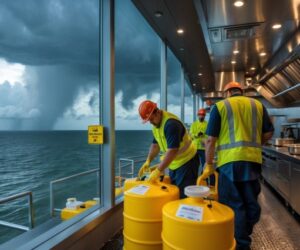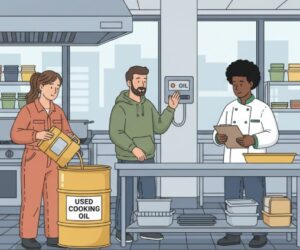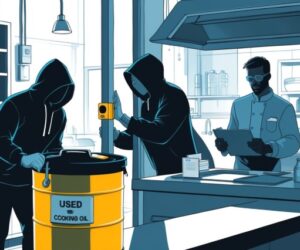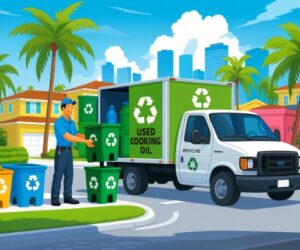
Emergency Oil Retrieval During Hurricane Season: What Miami Restaurants Should Know
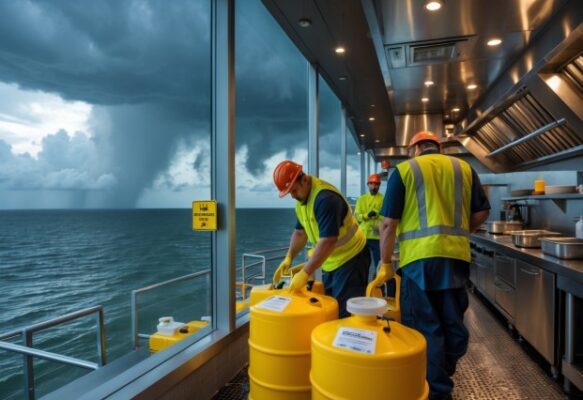
Hurricane season presents numerous challenges for Miami restaurants, particularly in terms of safely and legally handling used cooking oil.
Strong winds and flooding can wreck oil storage tanks, cause messy spills, and totally disrupt normal pickup schedules.
Emergency oil retrieval services become critical during hurricane season because Miami-Dade County regulations still apply, even when storms hit, and restaurants must stay compliant while protecting their equipment and the environment.
Getting ready before a storm—and knowing what to do afterward—can save you thousands in cleanup and fines.
Smart restaurant owners don’t wait around. They secure oil storage systems in advance and line up reliable emergency haulers who can arrive quickly when things go awry.
Knowing the local rules and having a plan in place can mean the difference between a quick bounce-back and weeks of headaches.
Key Takeaways
- Secure oil storage tanks before storms to prevent spills and ensure compliance with Miami-Dade regulations.
- Emergency oil retrieval helps you avoid big cleanup bills after hurricane damage.
- Select experienced local haulers who are familiar with Miami regulations and can respond promptly.
How Emergency Oil Retrieval Works in Miami (Hurricane Season)

When hurricane season hits, Miami restaurants must act quickly if their cooking oil systems become flooded, overflow, or appear to be contaminated.
Emergency retrieval crews follow special protocols, and the paperwork and response times differ from those of your everyday pickups.
What Counts as an “Emergency”?
Overfilled containers trigger emergency calls when oil levels reach 90% or more, or if automatic shutoffs fail to function. Storms often delay pickups, causing tanks to become dangerously full.
Compromised storage systems include cracked tanks, busted lids, or loose fittings that might leak in high winds. Even a tiny crack can turn into a disaster when heavy rain mixes with the oil.
Flooded oil containers are a nightmare. If stormwater enters, environmental threats increase rapidly, and contaminated oil can spill into drains or streets.
Drain system risks happen when oil threatens to enter Miami’s stormwater system. That’s a direct violation, and it forces an emergency response.
If you spot any of these issues, don’t hesitate—call emergency services right away. Waiting until the storm passes usually means bigger violations and much higher costs.
Typical Response SLAs (Same-Day/After-Hours Routes; Storm-Path Contingencies)
A same-day emergency response typically occurs within 4-6 hours during normal weather conditions. If you call after hours, crews may take 8-12 hours, depending on the number of people they’ve available.
Storm-path contingencies can slow things down. When a hurricane’s less than 48 hours out, emergency teams respond based on environmental risk, not who called first.
Pre-storm windows are your best bet for speed. If you call 24-72 hours before landfall, you may receive a crew within 2-4 hours.
During active storms, nobody’s coming out. Safety rules shut everything down if winds hit 39 mph or more in Miami-Dade.
Post-storm operations resume 12-24 hours after the winds subside. They’ll prioritize places with confirmed spills or big environmental threats.
Required Docs at Hand (Permit/FOG ID, Prior Manifests, Insurer Claim #)
FOG permit numbers need to be ready for crews. Miami-Dade requires that every commercial oil removal job be logged under a valid Fats, Oils, and Grease permit.
Prior pickup manifests provide crews with a heads-up about normal oil volumes and the location of your containers. This info helps them bring the right gear and disposal plan.
Insurance claim numbers come in handy if a storm caused the emergency. Many policies actually cover emergency oil removal after hurricane damage.
Property contact info is a must for after-hours access. Have backup phone numbers ready, since cell towers don’t always survive a storm.
Site maps showing oil storage locations enable crews to work more efficiently, especially in low-light conditions. Mark any electrical hazards or flood-prone spots clearly.
Grease Pros Recycling makes emergency oil retrieval simple and fast during hurricane season in Miami. Protect your restaurant, avoid fines, and stay operational—contact us today to schedule a service appointment.
If you’re ready to get started, call us now!
Miami-Dade Rules You Must Follow (Even in a Storm)
Hurricanes don’t pause Miami-Dade’s FOG program requirements or environmental rules.
Restaurants must still maintain current permits, follow proper disposal protocols, and promptly report incidents—even during emergencies.
FOG Permits, Pump-Out Cadence, and Manifest Uploads (What Inspectors Check)
Miami-Dade’s FOG portal checks compliance every night, hurricanes or not. The system automatically flags missing pump-out logs and manifest uploads.
Required pump-out schedules:
- High-volume restaurants: Every 30 days
- Medium-volume: Every 60 days
- Low-volume: Every 90 days
If you miss an upload, expect a $250 late fee within a day. Storms don’t get you out of this.
Permits must remain current throughout the entire season. Letting one expire means instant violations and possibly a closure order.
Inspectors check for:
- Current permit and renewal dates
- Complete pump-out records
- Manifest upload times
- Grease trap maintenance logs
The county cross-checks all this nightly. Upload manifests immediately after each pump-out to avoid automatic penalties.
Penalties for Improper Disposal or Storm-Drain Contamination
FOG violations during storms bring harsh penalties, especially if there’s environmental damage. Storm drain contamination is the costliest mistake.
Standard penalties:
- First offense: $500-$1,500
- Repeat: $2,500-$5,000
- Storm drain contamination: $10,000+
If a hurricane-related spill gets serious, the EPA might step in. That means even more fines on top of the county’s.
If inspectors catch anyone dumping into storm drains, they can shut the place down immediately. There’s no leniency during emergencies.
Things that make fines worse:
- Dumping during storm warnings
- Multiple violations at different locations
- Repeat offender status
- Clear environmental damage
The county treats hurricane-related violations as especially serious, since cleanup and risks skyrocket.
Who to Contact at DERM After Incidents (When, What to Report)
DERM keeps a 24/7 emergency line open during hurricane season for environmental incidents. Restaurants must report FOG-related problems immediately.
Emergency contact info:
- DERM Hotline: 305-372-6955
- After hours: 305-596-4357
- Email: pollution.complaint@miamidade.gov
Report these within 2 hours:
- Grease trap overflows intothe drains
- FOG equipment damage and spills
- Pump-out truck accidents on site
- Any visible environmental contamination
What you’ll need to share:
- Restaurant name and permit number
- Exact location and time
- Estimate of spill volume
- Cleanup steps you’ve already taken
DERM usually sends inspectors within 4 hours for serious cases. Reporting early can lower penalties if you demonstrate a good-faith effort to comply.
Miami-Dade Compliance at a Glance (Hurricane Season)
Restaurants that avoid trouble during storms typically have hurricane-specific compliance measures in place.
Pre-storm checklist:
- Update pump-out schedules
- Check permit status
- Upload any pending manifests
- Secure grease trap covers
During the storm:
- Keep an eye on grease trap levels
- Report any overflow right away
- Document all equipment damage
- Keep emergency contacts handy
After the storm:
- Inspect all FOG equipment
- Restart normal pump-outs within 7 days
- Report any environmental incidents
- Update DERM on your operating status
The county expects you to return to full compliance within one week after the storm. If you need more time, you’ll have to send a formal request with proof of storm damage.
Before the Storm: Secure Your Oil the Right Way
Protecting your oil means securing containers with hurricane-rated tie-downs and constructing spill barriers away from drains.
You’ll also want to set clear pickup thresholds and conduct a thorough inspection before the weather turns inclement.
Container Strapping & Anchoring Checklist (Wind Ratings, Tie-Downs)
Managers should use tie-downs rated for Category 3 hurricane winds (111-129 mph) on all oil containers. That’s usually enough for most storms Miami sees.
Steel strapping is best suited for large containers exceeding 55 gallons. Use two straps per container, one near the top and one lower down. Attach each strap to concrete anchors or steel brackets.
Ratchet tie-downs work for smaller containers. Select straps with a minimum load limit of 3,000 pounds. Skip the bungee cords and rope—they just don’t hold up in strong winds.
Cluster containers together to cut down wind exposure. Place heavier items on the windward side to shield the lighter ones. If you can, keep containers below fence height.
Anchor requirements:
- Concrete anchors: at least 3/8-inch diameter
- Steel brackets: 12-gauge or thicker
- Mounting depth: 4 inches into concrete
- Anchor spacing: No more than 6 feet apart
Test every anchor point before hurricane season. Give each connection a good yank with 200 pounds of force to make sure it’ll hold.
Secondary Containment (Berms, Mats) and Distance from Storm Drains
Oil spill containment gets really critical when storms hit and drainage systems overflow. Miami restaurants must set up barriers that can withstand 110% of the total oil volume stored onsite.
Containment berms are most effective for permanent storage areas. Build 6-inch high concrete or steel barriers around container groups.
Ensure that you seal all joints to prevent leaks from occurring during heavy rain. Don’t skimp on this step—it matters more than you think.
Spill mats are your go-to for temporary setups. Select mats specifically designed for use with petroleum products, featuring sealed edges.
Size these mats so they extend 3 feet beyond the edges of every container. That extra coverage can save you a headache later.
Keep these minimum distances from storm drains in mind:
- 50 feet for containers over 100 gallons
- 25 feet for containers 50-100 gallons
- 15 feet for containers under 50 gallons
Install drain covers as soon as storms threaten. Weighted tarps or commercial drain protectors are effective in keeping contaminated runoff out of city systems.
Design your containment areas with drainage slopes that send spills away from building foundations. Set up sump pumps in the lowest areas to remove rainwater once the storm passes.
Pre-Landfall Pickup Strategy (Thresholds to Trigger a Pre-Storm Route)
Smart restaurant operators plan for emergency oil pickup before hurricane conditions make collection impossible. Set up clear triggers so you know exactly when to start pre-storm removal.
Trigger thresholds for pickup requests:
- 72 hours before landfall: Category 1-2 storms
- 96 hours before landfall: Category 3+ storms
- When winds hit 25 mph sustained: All storm categories
Call your oil collection company as soon as any trigger activates. Most providers stop pickups 48-36 hours before the storm arrives to keep their crews safe.
Always put damaged or leaking containers first on your pickup list. These are the most significant spill risks during storms.
Next, remove any containers from flood-prone areas. If you need to self-haul, keep backup transportation ready.
It’s helpful to have relationships with a few collection companies. That way, you increase your odds of getting a pickup when demand spikes.
Document every pickup request—note the time, date, and get confirmation numbers. If a delay results in property damage, you’ll want to keep those records for insurance purposes.
Pre-Storm Readiness Checklist
Complete your final preparations 24 hours before tropical storm conditions begin. Use this checklist to double-check that everything’s covered.
Container Security:
- All tie-downs are properly tensioned
- Anchor points inspected for damage
- Container lids secured and sealed
- Groups positioned to reduce wind exposure
Spill Protection:
- Containment barriers installed and sealed
- Drain covers positioned and weighted
- Spill response materials are accessible
- Sump pumps tested and operational
Documentation:
- Container inventory updated with volumes
- Insurance contact numbers are readily available
- Pickup service confirmations received
- Emergency response plan reviewed with staff
Final Actions:
- Vulnerable containers moved to secure areas
- Outdoor electrical connections shut off
- Security cameras positioned to monitor storage areas
- Staff briefed on post-storm inspection procedures
Keep this checklist in a waterproof container you can grab after the storm. Also, include emergency contact numbers for oil cleanup and environmental response teams.
Don’t wait until containers overflow—Grease Pros Recycling offers reliable used cooking oil pickup that keeps your kitchen safe year-round. Stay compliant and storm-ready; contact us now to schedule a pickup.
If you’re ready to get started, call us now!
After the Storm: What to Do If Drums Flood or Shift
Storm-damaged oil drums need immediate attention to avoid environmental violations and safety issues.
Restaurant owners should follow specific inspection steps, promptly contain spills, and arrange for safe pickup while adhering to county reporting rules.
Four-Step Restart Inspection (Strap Tension, Berm Sheen, Vent Cap Check, Turbidity Test)
Step 1: Strap Tension Assessment
Check every drum’s securing straps for looseness or damage. You want no more than 2 inches of slack when you press down.
If the straps appear frayed or stretched, replace them immediately. Drums that moved during the storm need to be repositioned before you restart operations.
Use safe lifting techniques and avoid dragging drums across concrete, as it can scrape up the bottom.
Step 2: Berm Sheen Inspection
Look for any rainbow-colored film on water inside containment berms. Even a slight sheen indicates oil contamination that requires cleanup.
Snap photos of the visible sheen for your records. Use absorbent pads to remove contaminated water before pumping out the rest.
Step 3: Vent Cap Verification
Check every drum’s vent cap to make sure it’s sealed. Loose or missing caps let water in and oil out during storms.
Tighten caps by hand until they’re snug—don’t overdo it. If a cap’s damaged, swap it with an identical one from your oil supplier.
Step 4: Turbidity Testing
Check if the water in your containment area looks cloudy or discolored. Clear water usually indicates little contamination, but murky water may mean oil has been mixed in.
Shine a flashlight through the water from a few angles. Take photos and note the time for compliance records.
Spill Triage: Contain → Absorb → Report Per County Thresholds
Immediate Containment
Stop oil from spreading by setting absorbent booms around the spill area. Start from the outside and work your way in.
Block storm drain openings with absorbent pads—do this within the first 15 minutes after spotting a spill.
Absorption Process
Put oil-only absorbent pads right on the spill. These pads repel water and absorb oil quickly.
Switch out pads as they fill up. Toss used ones in labeled containers for hazardous waste disposal.
Miami-Dade Reporting Requirements
If a spill is 5 gallons or more, call Miami-Dade County within 2 hours. Smaller spills still need to be documented, but you don’t have to report them immediately.
Dial the 24-hour spill hotline at 305-372-6757. Provide them with the location, estimated amount, and an update on what you’ve done so far to contain it.
How to Stage Pickup Safely (Traffic Cones, Forklift Rules, Egress)
Traffic Control Setup
Put orange traffic cones 50 feet before the pickup area on both sides. That gives drivers enough time to slow down.
Use at least six cones to mark a clear work zone. Line them up straight to lead right to the pickup spot.
Forklift Operation Guidelines
Keep forklifts moving drums at a speed of less than 5 mph when near the pickup area. Stay at least 10 feet away from vehicles or people.
Ensure the forks are positioned correctly under the drum pallets before lifting. Don’t go over the forklift’s weight limit—3,000 pounds is typical for most restaurants.
Emergency Exit Planning
Always keep at least one exit path clear and 8 feet wide. No equipment or materials should block this route.
Post emergency contact numbers near the work area. Include the fire department, county environmental services, and your oil supplier.
Choosing an Emergency Hauler: What Matters in Miami
Miami restaurants should verify that their waste oil hauler maintains up-to-date licensing and utilizes hurricane-rated equipment. When storms are on the way, response time and route flexibility become huge.
Licensing & Manifests (Proof You’ll Pass Inspection)
Restaurants in Miami need haulers with current Florida Department of Environmental Protection permits. These show the company can legally move waste cooking oil across county lines.
Manifests are your paper trail. Every pickup requires a manifest that lists the oil type, amount, and destination facility.
The hauler should hand over copies within 48 hours.
Key licensing requirements include:
- DOT hazmat transportation certification
- Local business license in Miami-Dade County
- EPA identification numbers
- Insurance certificates with at least $1 million coverage
If you don’t have proper manifests, you risk fines up to $10,000 per violation. Inspectors often check paperwork during routine visits and after storms.
Hurricane-Rated, Lockable Containers & Theft Prevention
Standard containers cannot withstand hurricane winds exceeding 74 mph. Miami restaurants need Category 3-rated storage tanks with reinforced mounting.
Lockable lids help prevent theft and contamination. After storms, cooking oil prices can jump, making unsecured containers easy targets.
Heavy-duty padlocks and tamper-evident seals add basic protection.
Container specs for Miami:
- Wind rated for 125+ mph
- Mounted on concrete pads with hurricane straps
- Capacity: 200-300 gallons for most restaurants
- Material: Double-wall steel
Keep containers away from windows and overhead hazards. Place them near service roads so haulers can reach them even if debris blocks main streets.
Response Windows and Route Agility (Pre/Post-Landfall)
Haulers in Miami should collect oil 72 hours before the predicted landfall. That helps keep containers from overflowing if closures drag on.
After the storm, you really see which haulers are reliable. The good ones get back to work within 5-7 days after the hurricane passes.
Route flexibility is more valuable than a regular schedule. Haulers need backup routes in case the main roads flood or become blocked.
Companies with GPS tracking can provide restaurant managers with real-time updates, which is honestly a relief when everything else is chaotic.
Response timeline expectations:
- Pre-storm pickup: 72 hours before landfall
- Communication blackout: 24-48 hours during storm
- Route assessment: 2-3 days post-storm
- Service resumption: 5-7 days max
Vendor Comparison Matrix (What to Ask)
Go ahead and create a comparison chart before hurricane season arrives. Reach out to at least three Miami haulers and jot down what they can actually do.
| Question | Hauler A | Hauler B | Hauler C |
| Pre-storm pickup guarantee? | |||
| Hurricane container rating? | |||
| Average post-storm response time? | |||
| 24/7 emergency contact? | |||
| Backup route planning? |
Essential questions include:
- Do you keep service running during tropical storm warnings?
- What backup equipment do you actually have in Miami?
- If my containers get damaged, can you bring emergency replacements?
- Do you help with post-storm cleanup?
Write down every answer you get. When storms hit and staff clear out, verbal promises don’t mean much.
Why Miami Restaurants Trust GreasePros Recycling
When a storm is bearing down, you need more than a vendor—you need a partner who shows up every time.
That’s why Miami restaurants count on GreasePros Recycling for emergency oil retrieval during hurricane season.
Our licensed team provides free, lockable containers, same-day retrieval, and full DERM-compliant manifests—backed by the voices of real local clients:
- “GreasePro’s is amazing. They were responsive, punctual, and professional. 5-star service.” — Alex C.
- “GreasePros Recycling is the BEST BY FAR compared to other companies… Always on time, knowledgeable, professional, and 100% honest. Customer for life!” — Joey B.
- “Great to deal with, fair pricing. I needed two abandoned grease tanks emptied and removed—they were out the next day and had the job done in 45 minutes.” — Peter M.
- “They were responsive, punctual, professional, and got the job done quickly! Thank you to you and your amazing team.” — Caterine G.
These testimonials reflect what we do best: show up fast, do the job right, and help you avoid costly fines or shutdowns—even when storms hit Miami hard.
Need emergency oil retrieval before or after a hurricane? Call (786) 655-7070 now—our Miami team is on standby 24/7.
Contact Us Today For An Appointment
Frequently Asked Questions
What is emergency oil retrieval during hurricane season?
Emergency oil retrieval is the rapid removal of used cooking oil and grease from restaurants and food facilities when storms or flooding compromise storage containers. It prevents spills, protects storm drains, and ensures regulatory compliance.
Why is emergency oil retrieval important for restaurants in hurricane season?
It prevents hazardous spills, avoids expensive fines from Miami-Dade FOG enforcement, and ensures restaurants can reopen quickly after a storm with clean, compliant facilities.
How fast can emergency oil be retrieved during a storm?
Licensed haulers in Miami typically offer same-day or 24/7 emergency pickup during hurricane alerts, with priority routes arranged before and after landfall.
What should restaurants do if oil containers are flooded?
Treat flooded drums as contaminated, isolate them, take photos for insurance purposes, and contact a licensed hauler immediately for safe retrieval and manifest documentation.
Are there Miami-Dade compliance rules during hurricane season?
Yes. Restaurants must maintain active FOG permits, use licensed haulers, and submit manifests even if storms disrupt normal service. Discharging oil into storm drains can result in heavy fines.
What type of containers are best suited for storing oil during hurricane season?
Hurricane-rated, lockable, and anchored containers are recommended. Secondary containment, like berms or spill mats, reduces flood risks and theft during evacuations.
Will insurance cover emergency oil retrieval costs?
Most restaurant insurance policies cover cleanup and retrieval when supported by documented evidence, including photos, manifests, and hauler certificates. Maintaining proper records is key to expedited claim approvals.
How can Miami restaurants prepare for oil retrieval before a hurricane?
Schedule pre-storm pickups when drums are near capacity, secure lids and straps, keep 20–30% headspace, and store emergency contact numbers for licensed haulers.
